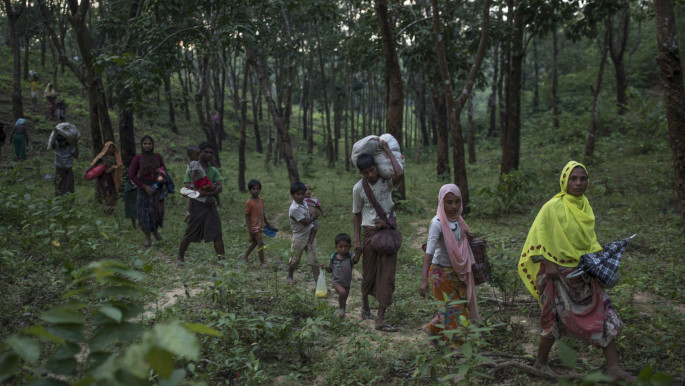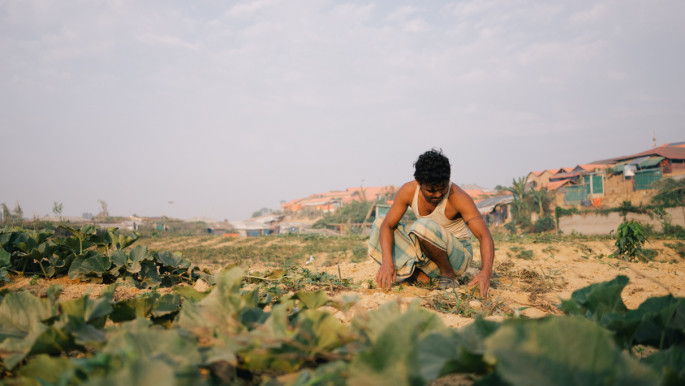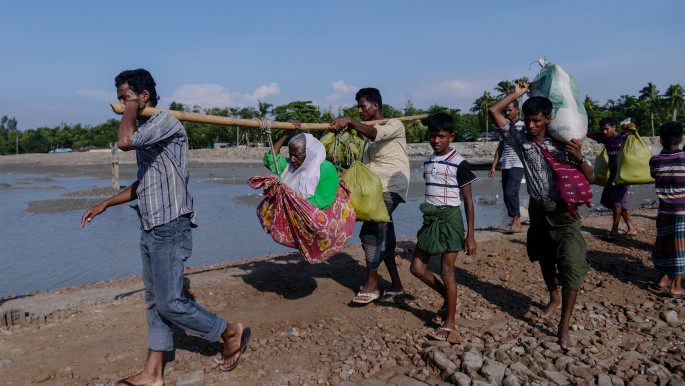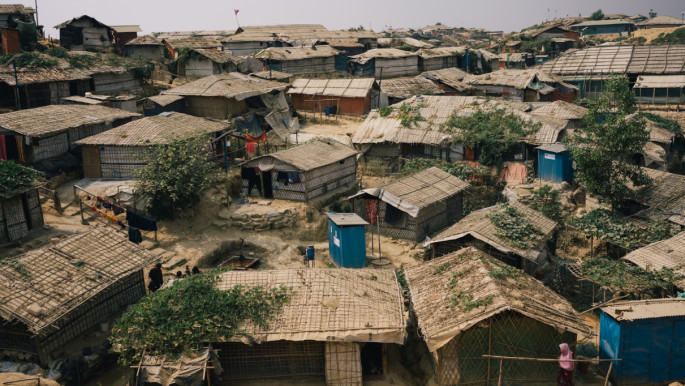Rohingya refugees regreen deforested land on Myanmar's border
Where a year ago there were only the desolate remains of a forest scythed from hills to house hundreds of thousands in the world's largest refugee camp, Rohingya refugee Hazara Khatun now picks the vegetables she will use for dinner.
Inside a small plastic bag hanging from her wrist is the precious harvest: a few small potatoes, a bundle of leafy greens, and a handful of green beans.
All were grown by two of her grandsons, who are among those trying to rekindle an element of their former lives. Many were farmers across the border in Myanmar's Rakhine state before a military operation in August 2017 killed thousands of civilians and forced the majority of the Rohingya minority into an entirely different life as refugees in a bordering area in Bangladesh.
Kutupalong, the megacamp that alongside several satellite settlements in the same corner of Bangladesh grew to house the 740,000 new refugees, became a home built of necessity.
It emerged from forest land stripped bare to make way for the bamboo-and-tarpaulin makeshift shelters that have become semi-permanent in the absence of any changes in Myanmar that could guarantee a safe return.
 |
|
| Read also: Bangladeshi forests stripped bare as Rohingya refugees battle to survive |
When The New Arab visited after the 2017 influx, evidence of the active deforestation was everywhere.
Where the refugees were not clearing space for the still-expanding camp, others were hiking hours into the rapidly disappearing forest to gather precious firewood by cutting down trees and even ripping roots from the hills.
Returning to Kutupalong a year and a half later, it is still a harsh, ravaged space, but the deforestation has slowed; its inhabitants are finding ways to survive by trying to nourish the damaged environment, often through their own small initiatives but also with the help of government planning. In April 2018, the UN's Food and Agriculture Organization (FAO) handed out 25,000 micro-gardening kits.
"My grandsons started growing this, it makes me happy when I come here and see it," Hazara said, standing in front of their plots. It has made a difference, she said, by supplementing the mundane ration of lentils and rice the refugees have had to live on.
"We started growing so we could have some beans and potatoes to eat," she said. "We can also earn money by selling them because there is no work for us here. We can grow them and go to other places to sell them."
Living off the land is natural for the Rohingya, who lived a predominantly agricultural life in Myanmar. Today, the UN estimates only around 400,000 Rohingya remain in Myanmar, compared to almost one million now in Bangladesh.
On the camp's fringes, where the sea of tents thins and the mutilated remains of the forest begin, a few of the refugees, such as Hazara's grandsons, have begun to cultivate small but treasured patches of land.
Others inject new life into their surroundings by simply growing vegetables on their shelters, draping their sparse tents in a layer of green.
Leafy vegetables and beans grow on vines hanging from the bamboo racks the refugees have fixed to their homes, and occasionally a more impressive fully grown bottle gourd hangs – valued because meals can be made from its leaves, flesh and seeds.
The sudden trend for these vertical gardens has struck a surprising contrast with the image the camp offered in the first year after the influx. Kutupalong and other camps had existed since the 1990s, but the military operation in August 2017 forced an unprecedented number across the border.
 |
When we got here, the environment was bad, there was nothing green, nothing beautiful. But what could we do, we had to leave our own country |  |
The UN estimates at least 10,000 Rohingya were killed, and has described the campaign as "genocidal." In Bangladesh, the Rohingya were left living in a place completely alien from their homes; devoid of greenery and dry in the summer, but wet, exposed and vulnerable to landslides during the cyclone and monsoon seasons.
"When we got here, the environment was bad, there was nothing green, nothing beautiful. But what could we do, we had to leave our own country," said 25-year-old Hamid Hussein, as he rummaged for potatoes through the loose soil he has been growing on.
Like Hazara's grandsons, Hussein rents the land he farms from local Bangladeshi villagers who claim it belonged to them before the Rohingya arrival in 2017. They now allow the refugees to use it for a fee of around $5 a month – a precious amount for the refugees who are not allowed to formally work.
 |
|
| Rohingya refugee Hamid Hussein searches for potatoes grown on a rare plot of land near his home in Kutupalong [Kaamil Ahmed/Mongabay] |
Hussein leaves his home at sunrise to tend to this plot of land, examining the vines of the gourds he grows and looking for anything that might be ripe for harvest.
The camp is unusually serene at dawn, a rare chance for the chirping birds to be heard above the heaving human population. The only activity comes from children already at the schools, which only offer primary education for pre-teen children, and other amateur farmers busying themselves.
Some tend small plots like Hussein's while others inspect their hanging gardens or mini-plots they've created by simply fencing off a scrap of land beside a pathway.
"The difference between me and others is around my house there are green things, but in other areas there is not even one tree," said Hussein.
"In the past we all were involved in farming, but here they feel so upset because they don't have that anymore."
Enterprising Rohingya have managed to set up small businesses serving the needs of the refugee communities, ranging from simple tea shops to tailoring services.
Full-blown fresh-food markets have also emerged, the trading run by local Bangladeshi farmers as well as Rohingya like Hussein, allowing him to use what he grows on his land to not only feed himself but also generate an income. But the land, he said, also gives him a sense of duty and connection to his community; when he can, he saves spare vegetables to share with his neighbours.
Like most, Hussein started his farm after the monsoon season and has mostly driven himself, buying the seeds he needs from Bangladeshi markets. But there has also been encouragement from NGOs .
"People growing their own food, it's not only great that they're able to add a little bit of their own food to the boring food they receive, which is legumes and rice, [but] throw a little green in there and it makes a big difference to your life," said Peter Agnew, the FAO's coordinator for the Rohingya crisis.
"I think there's also something really positive about growing something in your house … nurturing something is good and therapeutic."
Reversing the destruction
Surviving the harsh environment has not only been a concern for the refugees forced to live in it; the Bangladeshi government and the humanitarian agencies it partners with, like the FAO, have been focused on first stopping and then reversing the environmental damage to the forests and water supplies that followed the refugees.
The majority of that damage has come in the form of deforestation. A report by the UN Development Programme in September 2018 said 4,300 acres (1,740 hectares) of forest had been damaged.
A study by the University of Georgia and University of Texas, which used satellite imagery to estimate that Kutupalong grew 835 percent after the 2017 influx, said that in reality, deforestation was much higher than official statistics – the camps, they concluded, have encroached on more than 5,650 acres (2,290 hectares) of forest.
 |
|
| Read also: Exodus of Rohingya from Myanmar to Bangladesh sparks ecological crisis |
This has made the refugee population more vulnerable to cyclones and landslides on the denuded hills their shelters sit upon.
There are also fears of long-term damage to the soil in an ecosystem that's home to Asian elephants (Elephas maximus) and, according to the Bangladeshi conservation network Nishorgo, the country's last population of the long-tailed macaque (Macaca fascicularis).
The work to address the problem is under way: more than 340,000 saplings were planted in 2018, and the FAO's Agnew said some of the trees have already grown three times in size.
He said the impact of some of the planting will already be seen during the upcoming monsoon when, unlike last year, the roots that have been able to take hold in planted hills will reduce landslides.
Competing for water
There are also increasing concerns about water scarcity, which is connected to deforestation. Even before the August 2017 influx, parts of the region already suffered from water shortages. That was exacerbated by the sheer number of people now drawing from the same water sources.
Agnew said those sources were not replenished last year, when there was also an unusually dry rainy season; most of the water simply ran straight back into the sea because the deforested hills lacked the required greenery to pull rainwater back into the aquifer.
 |
|
| Rohingya refugees missing their lives in fertile Arakan state have tried to inject some greenery back into their new environment by growing vegetables from their plastic shelters [Kaamil Ahmed/Mongabay] |
A March 2019 report by the UN's International Organization for Migration (IOM), which runs the humanitarian response, categorised 29,000 Rohingya as facing "very high severity" water shortages, the most extreme category.
Some 300,000 were only a level better, meaning that more than a third of refugees had serious problems accessing water.
The effects are visible. In places where water pumps have run dry, the refugees rely on tanks of water that are trucked in daily and distributed at fixed hours.
Rows of plastic water cans sit in rows as camp leaders try to ensure the fair share is assigned to the dozens of refugees huddled around a few flimsy taps coughing out the precious supply.
According to the one of those camp leaders, 30-year-old Mohammed Ismail, the fair share is five litres (1.3 gallons) per person – significantly below the World Health Organization's recommended minimum of 7.5 to 15 litres (two to four gallons) per person per day.
 |
Even before the August 2017 influx, parts of the region already suffered from water shortages. That was exacerbated by the sheer number of people now drawing from the same water sources |  |
In Ismail's section of the Unchiparang camp, south of Kutupalong, around 500 families rely on a single water source. They start queuing well before the water starts pumping at 9am and wait until it runs dry.
"Some of the people will be able to fill half a bucket, some will get nothing because it will run out," Ismail said, pointing uphill toward the tank.
Attempts have been made to install deep tube wells, he said, but they found nothing.
"This is causing regular violence between people [at the pump] because some people get water and some people don't. They try to get their water before others," he said.
Ensuring no one takes more than their fair share of water is left to the camp leaders like Ismail, volunteers who are responsible for 100 families each and have to settle the arguments and occasional scuffles that break out between frustrated refugees, in the absence of any law enforcement inside the camps.
Agnew, who is working with the government on restoring the environment, said a five-year plan is being devised that will pinpoint the most effective areas to rehabilitate the forest and the water supplies, building on the work that has already been done.
Much of the planting that has been done was with deep-rooted vetiver plants aimed at stabilising the hills. The key going forward will be to plant a variety of vegetation that will increase the health of the environment, Agnew said.
A lot of the reforestation efforts will also focus on areas that will most help absorption of rain into the groundwater.
"This year's a lot more sophisticated than last year, when we were in panic mode," he said.
Reversing the environmental strain is also considered important for the long-term presence of the Rohingya, which seems likely as long as it's considered unsafe for them to return to Myanmar, to avoid conflict with the area's previous inhabitants.
Kutupalong falls directly within part of the Teknaf Game Reserve, described by the UNDP as Bangladesh's "most important forest ecosystem," and the site of migratory paths used by an estimated 100 Asian elephants, bewildered by the drastic change to their environment.
At least 14 refugees have been killed by elephants that have strayed into the middle of the camps, many of them in the first year after the refugees arrived, forcing the UN's refugee agency, the UNHCR, into building watchtowers and training volunteers on how to guide the animals away from refugees.
It has been harder to deal with tensions with the local Bangladeshi community, who feel they now have to compete for already scarce water supplies and lament the scale of the deforestation caused by the Rohingya chopping trees for firewood. Around four football pitches of forest were being cut down per day, according to the FAO.
It took more than a year for that to be halted, through a program to distribute cooking gas to households. Agnew said the programme has not only saved the forest but stopped putting the Rohingya in conflict with locals when they go out to collect firewood.
After initially leaning on the environment to deal with the scale of the refugee crisis, Agnew said it's now crucial to ensure future provisions for the refugees are more sustainable, before the environmental destruction becomes permanent.
"We still have time, if we put the right system in place, protect the forest and the water this year, we can still do it," he said.
"We took and we took from this environment and it saved a lot of lives," he said.
"Now we've taken to the point that there's nothing left to take. We have to start putting back."
Kaamil Ahmed is a foreign correspondent who has reported on conflicts, labour and the environment in South Asia and the Middle East.
Follow him on Twitter: @kaamilahmed
This article was originally published on Mongabay







